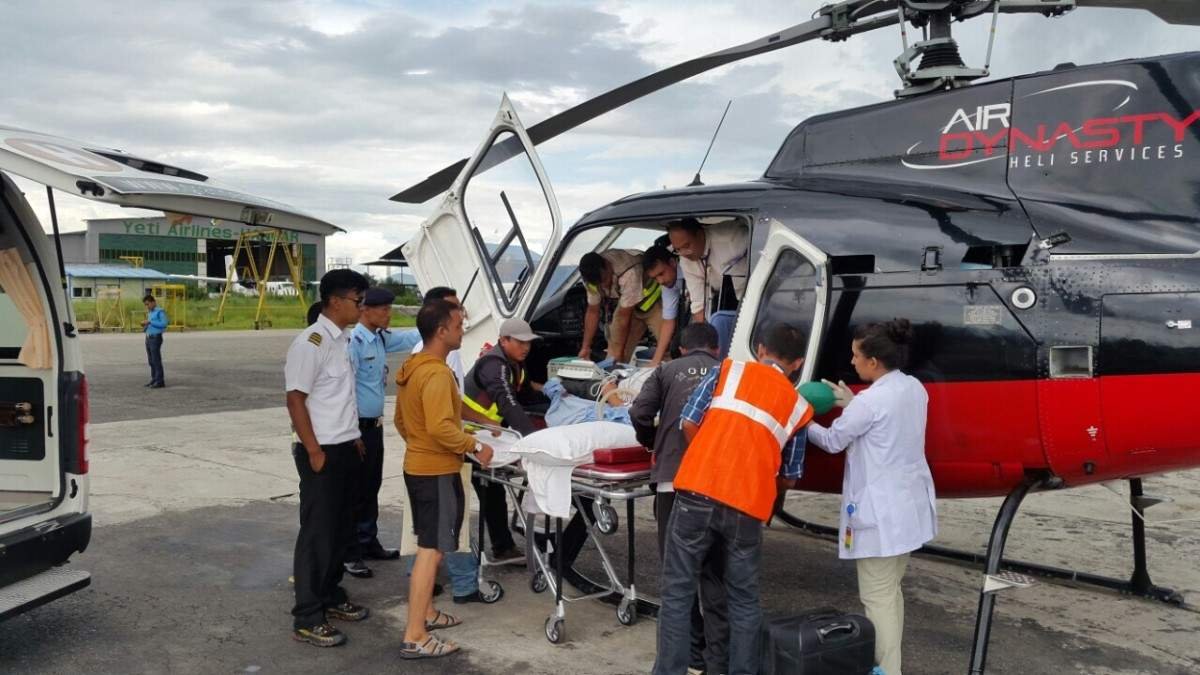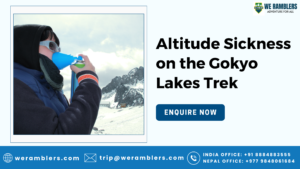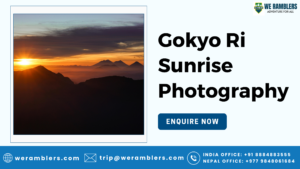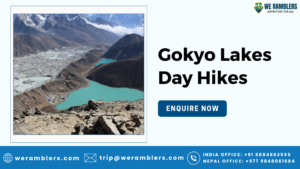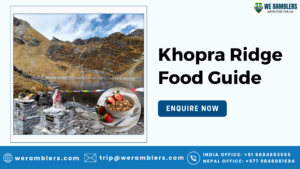Why Adventure Insurance Is Essential for Trekking in Nepal – Everything You Need to Know
Trekking in Nepal is a life-changing experience. From the towering peaks of the Himalayas to the serene trails of the Annapurna region, the country offers unparalleled opportunities for adventure and cultural immersion. Whether you’re navigating the challenging Three Passes Trek or enjoying the scenic Khopra Ridge Trek, the allure of Nepal’s landscapes is undeniable.
However, these majestic terrains come with inherent risks. High-altitude treks in Nepal can expose you to unpredictable weather, altitude sickness, and remote trails far from immediate medical assistance. Even seasoned trekkers can find themselves in unforeseen situations. This is where adventure insurance becomes not just advisable but essential.
Adventure insurance for trekking in Nepal ensures that you’re protected against potential mishaps, from medical emergencies to trip cancellations. It’s a safety net that allows you to focus on the journey, knowing that you’re covered if something unexpected happens.
Why Adventure Insurance Is Needed for Trekking in Nepal
Trekking in Nepal often involves traversing high-altitude regions, where the air is thin, and the weather can change rapidly. Altitude sickness is a common concern, especially for those ascending above 3,000 meters. Symptoms can range from mild headaches to severe conditions like High Altitude Pulmonary Edema (HAPE) or High-Altitude Cerebral Edema (HACE), both of which require immediate medical attention.
Standard travel insurance typically doesn’t cover activities above certain altitudes or in remote areas. It means that in the event of an emergency, such as the need for a helicopter evacuation—which can cost between $3,000 to $12,000, you might find yourself bearing the full expense.
Moreover, popular trekking routes like the Everest Base Camp, Annapurna Circuit, and Manaslu Circuit are often in remote locations with limited access to medical facilities. In such scenarios, having high-altitude insurance in Nepal is not just a precaution; it’s a necessity.
What Trekking Insurance Typically Covers
When selecting adventure insurance for trekking in Nepal, it’s crucial to understand the scope of coverage. A comprehensive policy should include
- Emergency Helicopter Rescue and Evacuation: Coverage for evacuations from altitudes above 3,000 meters.
- Medical Treatment and Hospital Admission: Expenses related to injuries or illnesses sustained during the trek, including hospital stays in Nepal or repatriation to your home country.
- Trip Interruption, Delay, or Cancellation: Reimbursement for unforeseen events that disrupt your travel plans.
- Lost or Stolen Gear, Baggage Loss: Compensation for essential equipment or personal items that are lost or stolen.
- Accidental Death or Dismemberment: Financial support in the unfortunate event of severe accidents.
It’s essential to read the fine print and ensure that the policy covers trekking activities up to the altitudes you’ll be reaching, especially if you’re planning routes like the Three Passes Trek, Gokyo Lakes Trek, Everest Base Camp Trek, Annapurna Circuit Trek, Manaslu Circuit Trek, Dhaulagiri Circuit Trek, Kangchenjunga Circuit Trek, or numerous other treks that ascend above 5,000 meters.
Who Should Get Trekking Insurance?
Adventure insurance is vital for anyone planning to trek in Nepal, regardless of experience level.
- First-Time Trekkers: Unfamiliarity with high-altitude conditions makes insurance a must.
- Experienced Trekkers: Even seasoned hikers can face unexpected challenges.
- Solo or Guided Trekkers: Whether you’re on your own or with a group, risks remain.
- Trekkers in Remote or Restricted Regions: Areas like the Three Passes, Manaslu Circuit, Dhaulagiri Circuit, and Kangchenjunga Circuit are remote, making emergency services harder to access.
- Anyone Trekking Above 3,000 Meters: Altitude increases risks, making insurance essential.
In essence, if you’re setting foot on Nepal’s trekking trails, having trekking insurance in Nepal is a non-negotiable aspect of your preparation.
Top Insurance Providers Offering Trekking Insurance for Nepal
Selecting the right insurance provider is crucial. Here are some reputable companies offering policies suitable for Nepal treks:
- ASC360: Includes coverage for trekking, hiking, and climbing above 8,000 meters. They have significant experience in Nepal and offer a variety of adventure insurance options.
- World Nomads: Offers coverage for trekking up to 6,000 meters, including emergency evacuation.
- Global Rescue: Specializes in medical evacuations and field rescues, ideal for remote treks.
- IMG Global: Provides comprehensive travel insurance with options for adventure sports.
- Allianz Travel: Offers customizable plans, including coverage for high-altitude trekking.
- Seven Corners: Known for flexible policies that cater to adventure travelers.
- Travel Guard (AIG): Provides extensive coverage options, including trip cancellations and medical emergencies.
- Alpenverein (Austrian Alpine Club): Offers affordable insurance with coverage for helicopter rescues up to 6,000 meters.
- Adventure Care: A recently introduced insurance company in Nepal that offers all forms of adventure insurance for trekking in Nepal.
Not all the companies listed above provide insurance for all the citizens across the world; some of them provide it to specific citizens only. Before purchasing, ensure the policy covers the specific altitudes and activities of your planned trek.
How to Choose the Right Trekking Insurance Policy?
When selecting a policy, consider the following:
- Altitude Coverage: Ensure the policy covers the maximum altitude of your trek.
- Evacuation Coverage: Look for policies that include helicopter rescue and emergency evacuation.
- Region-Specific Inclusions: Some policies may exclude certain areas; verify that your trekking region is covered.
- Pre-Existing Conditions: If you have health issues, check if they’re covered.
- Helicopter Evacuation Clauses: Confirm that helicopter rescues are included, especially for remote treks.
- Cashless Treatment or Claim Procedures: Understand the claim process and whether cashless treatments are available.
- Duration and Cancellation Policies: Ensure the policy duration aligns with your trek and includes trip cancellation coverage.
- Add-Ons: Consider additional coverage for gear, trip delays, or other specific needs.
Taking the time to thoroughly research and select the right policy ensures peace of mind during your adventure.
Helicopter Rescue During Trekking: A Critical Lifesaver
In the event of severe altitude sickness or injury, helicopter evacuation becomes a critical necessity. For instance, if a trekker experiences HAPE at 5,000 meters during the Three Passes Trek, or any other similar high-altitude treks in Nepal immediate evacuation is essential. Helicopter rescues in Nepal can cost between $3,000 to $12,000, a hefty sum without insurance.
At We Ramblers, we ensure that all our trekking packages are compatible with international trekking insurance. In emergencies, we coordinate promptly with insurance providers to facilitate swift evacuations, prioritizing your safety above all.
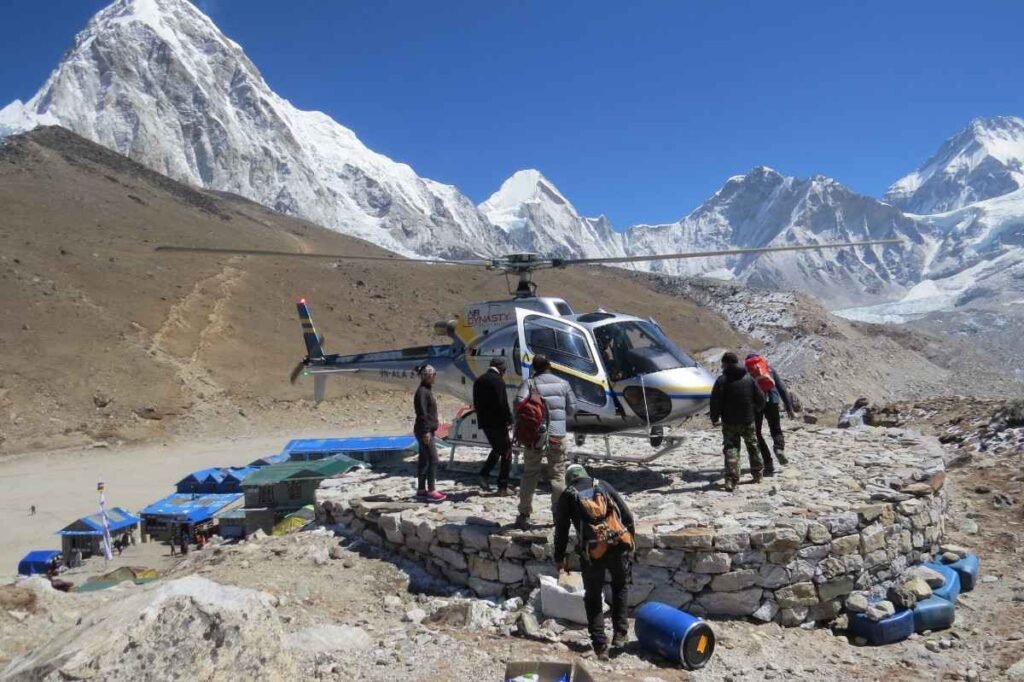
Medical Admission & Treatment: What’s Covered?
Should you require medical attention during your trek, having comprehensive insurance is invaluable. In Nepal, medical facilities in Kathmandu and Pokhara are well-equipped to handle various emergencies. Insurance typically covers:
- Altitude Sickness Treatment: Including medications and hospital stays.
- Injuries: Such as fractures or sprains sustained during the trek.
- Repatriation: If necessary, transportation back to your home country.
The We Ramblers team assists clients in navigating the medical system, ensuring that you receive timely and appropriate care.
We Ramblers Trekking Packages Fully Covered by Insurance
At We Ramblers, we offer a range of trekking packages, all designed to be compatible with international trekking insurance. Our team assists clients in understanding insurance requirements and facilitates coordination with providers.
Everest Base Camp Trek Insurance
- Altitude: 5,364 meters.
- Difficulty: Moderate to Difficult.
- Best Time: March–May, October–December.
- Key Highlights: Tengboche Monastery, Khumbu Glacier, Kala Patthar sunrise, Sherpa villages, panoramic views of Everest.
- Insurance Relevance: With extreme altitudes, harsh weather changes, and remote access, trekking insurance in Nepal with helicopter rescue coverage is critical. Cases of AMS are frequent, and evacuation is possible only by air.
We assist trekkers with altitude acclimatization and coordinate swiftly with rescue providers in emergencies, ensuring your high-altitude insurance in Nepal works effectively.
Annapurna Base Camp Trek Insurance
- Altitude: 4,130 meters.
- Difficulty: Moderate.
- Best Time: March–May, September–December.
- Key Highlights: Machhapuchhare Base Camp, rhododendron forests, hot springs at Jhinu Danda, and Annapurna Sanctuary amphitheater.
- Insurance Relevance: Although slightly less remote than EBC, sudden weather changes, steep climbs, and the risk of landslides make Nepal trek insurance coverage important. Helicopter evacuation is the only option from ABC.
We guide trekkers through a slow ascent and help confirm if their insurance includes evacuation and treatment at private hospitals in Pokhara or Kathmandu.
Manaslu Circuit Trek Insurance
- Altitude: 5,160 meters (Larkya La Pass).
- Difficulty: Challenging.
- Best Time: March–May, September–November.
- Key Highlights: Remote Tibetan villages, Budhi Gandaki River gorge, high passes, glacier views, and rich biodiversity.
- Insurance Relevance: As a restricted region, it requires a special permit and travel with a licensed guide. Its remoteness means emergency helicopter evacuation is often the only recourse, making trekking insurance in Nepal essential.
We help you select the best adventure insurance needed for trekking in Nepal that includes restricted region access and fast claims processing.
Langtang Valley Trek Insurance
- Altitude: 3,870 meters (Kyanjin Gompa).
- Difficulty: Easy to Moderate.
- Best Time: March–May, September–December.
- Key Highlights: Tamang culture, Langtang National Park, Kyanjin Ri viewpoint, glacial rivers, yak farms.
- Insurance Relevance: Despite being closer to Kathmandu, landslides and remote trails make trekking insurance up to 6000m advisable. Many overlook insurance on this trek—but even a basic policy with medical treatment and evacuation can be lifesaving.
We support sustainable tourism here and ensure clients are covered for natural disaster disruptions or medical emergencies.
Khopra Ridge Trek Insurance
- Altitude: 4,600 meters.
- Difficulty: Moderate.
- Best Time: March–May, September–December.
- Key Highlights: Panoramic views of Dhaulagiri, Annapurna South, and Nilgiri; Khayar Lake; and less-crowded trails.
- Insurance Relevance: As a newer and less-traveled route, medical help is not readily available. Adventure insurance for trekking in Nepal covering off-the-beaten-path evacuation is a must here.
We offer the Khopra Ridge Trek with Khayer Lake to those who seek solitude and raw Himalayan beauty, with full insurance validation and safety support on all itineraries.
Gokyo Lakes Trek Insurance
- Altitude: 5,357 meters (Gokyo Ri).
- Difficulty: Moderate to Difficult.
- Best Time: March–May, October–December.
- Key Highlights: Stunning turquoise glacial lakes, Ngozumpa Glacier, Renjo La Pass (optional), panoramic Everest views.
- Insurance Relevance: Severe cold, high passes, and isolation make trekking insurance in Nepal indispensable. You’re walking near the world’s largest glacier at high altitudes—AMS and weather disruptions are real threats.
We check your insurance for altitude limits, helicopter rescue clauses, and emergency repatriation details before confirming your booking.
Annapurna Circuit Trek Insurance
- Altitude: 5,416 meters (Thorong La Pass).
- Difficulty: Moderate to Difficult.
- Best Time: March–May, September–December.
- Key Highlights: Diverse climate zones, Muktinath temple, Manang village, Tilicho Lake, dramatic mountain scenery, and apple orchards.
- Insurance Relevance: Long trekking days at high elevations increase the risk of fatigue and illness. Thorong La is often closed due to snowstorms. Best travel insurance for Nepal trekking must include trip cancellation, evacuation, and gear coverage.
We prepare trekkers with acclimatization plans and help them secure insurance that supports both trip delays and altitude-related issues.
Three Passes Trek Insurance
- Altitude: Up to 5, 645 meters (Kongma La, Cho La, Renjo La).
- Difficulty: Difficult.
- Best Time: April–May, October–December.
- Key Highlights: Crosses three high passes, Kala Patthar, Chukhung Ri, EBC and Gokyo, offers 360-degree mountain panoramas.
- Insurance Relevance: This is among the toughest treks in Nepal and is only for experienced trekkers. You must have trekking insurance up to 6000m with helicopter rescue coverage Nepal trekking clearly stated. Rescuing from Cho La, Renjo La, or Kongma La is not feasible on foot.
All We Ramblers treks are designed with safety as a priority. We ensure our trekkers have valid insurance and offer support in claim processing, emergency coordination, and selecting appropriate policies suited to their trek.
Technical Details and FAQs on Trekking Insurance in Nepal
Do you need insurance before getting a trekking permit?
Yes, insurance is often required to obtain permits, especially for treks over 3,000 meters. The authorities may ask for proof that your insurance covers helicopter evacuation and high-altitude trekking. It’s best to secure insurance first.
What is the minimum recommended insurance coverage?
You should have a policy that covers at least $100,000 in medical evacuation and treatment, especially for remote treks. For higher-altitude or technical routes, higher limits are recommended due to potential helicopter evacuation costs.
Is proof of insurance required at checkpoints?
In many high-altitude and restricted trekking regions, including Everest and Manaslu, authorities may check insurance proof at permit issuance or during checkpoints. Always carry a digital and physical copy of your policy with you during the trek. For many treks, though, insurance is not needed. But it’s highly recommended for treks in Nepal.
Can I buy trekking insurance after arriving in Nepal?
Some local providers offer basic coverage after arrival, but it’s risky. International insurance is more comprehensive and should be purchased before your trip. Last-minute local plans may not cover helicopter rescues or high altitudes.
What are common insurance exclusions for trekking?
Most policies exclude coverage for:
- Altitude above their stated limit.
- Pre-existing conditions.
- Unlicensed guides.
- Extreme sports are beyond trekking.
Always read the fine print to avoid claim denials.
What if I get sick before the trek begins?
If your policy includes trip cancellation coverage, you may be reimbursed for prepaid costs like flights, permits, or guide fees. Ensure your policy includes cancellation due to medical conditions or illness before departure.
Does travel insurance cover lost gear or theft?
Yes, good adventure travel insurance includes coverage for lost, stolen, or damaged gear. However, expensive electronics may have a limit. File a police report and retain receipts or photos for a smoother claims process.
What medical services are available in Nepal?
Kathmandu and Pokhara have reputable private hospitals. On the trails, basic clinics or health posts may exist, but for serious conditions, helicopter evacuation is the only option. Insurance ensures you’re treated quickly without upfront costs.
Is helicopter rescue covered in all insurance policies?
Not all policies include it. You must explicitly check that helicopter rescue coverage is included and valid up to the altitude of your trek. We Ramblers helps confirm this during trip preparation and insurance verification.
Why choose We Ramblers for an insured trek?
We Ramblers is trusted by thousands for safe, guided Himalayan treks. We help you choose the best adventure insurance needed for trekking in Nepal, guide you in emergencies, and ensure your insurance is valid for your trek.
Book Your Nepal Trekking Package Today
Trekking in Nepal is a thrilling adventure through awe-inspiring landscapes, but it’s not without its risks. From unexpected altitude sickness to sudden injuries in remote areas, the potential dangers are very real—and often costly. That’s why investing in the best travel insurance for Nepal trekking is not just smart, it’s essential.
With policies that include trekking insurance up to 6000m, helicopter rescue coverage Nepal trekking, and medical evacuation for high-altitude trekking, you’re covered for the most unpredictable scenarios. Whether you’re planning the Manaslu Circuit Trek, Three Passes Trek, or classic routes like Everest Base Camp, trekking insurance in Nepal is your safety net.
Ready to begin your Himalayan journey with insurance-backed safety? Contact us today to learn more about our trekking packages.

